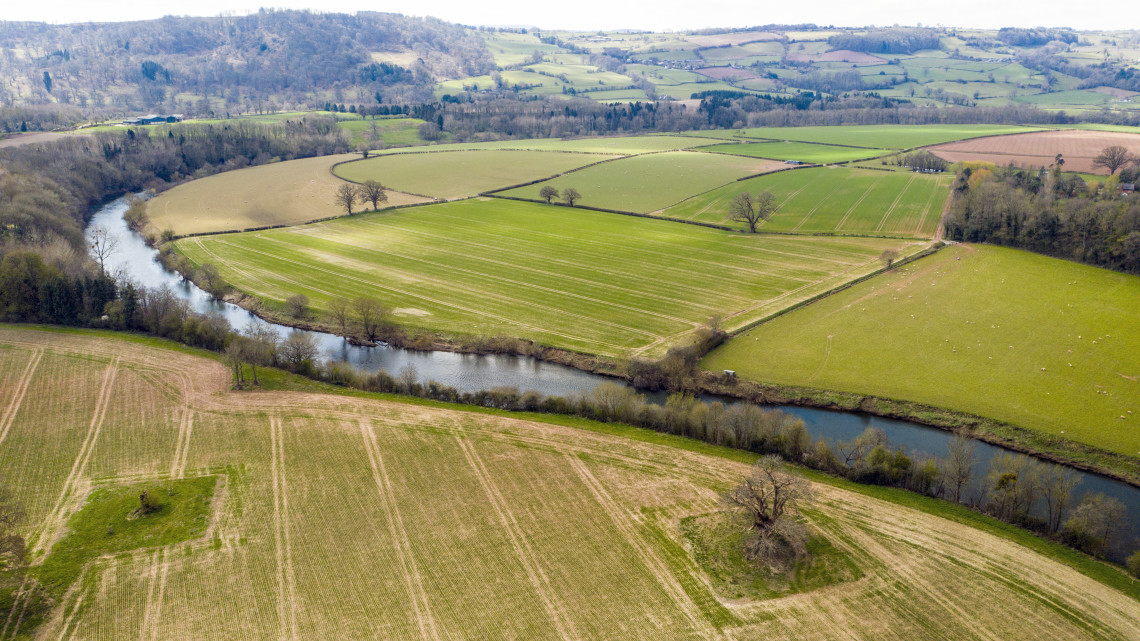As we all know by now, March turned out to be an extraordinary period, for anglers as well as the rest of the population. At the beginning of the month the Coronovirus epidemic was known to be a threat, but somehow it still seemed a distant one, similar to a number of unsatisfactory political or military situations around the world. It was something to worry about briefly while listening to the news and before getting on with the day. In my case I was still thinking more about the recent floods on our rivers. The diary paragraph below was written just before the season opened on the 3rd.
It is early March and suddenly it does seem like spring. The sun is shining today, which is something we haven’t seen for a while and we are promised a dry week. Tomorrow the new season starts and while I doubt that any fishing will get done for a while, the flood levels are slowly falling off and we are starting to get some damage assessments, to river banks as well as to houses. Merthyr Tydfil Angling Association report severe damage on the banks of their Mardy beat on the middle Usk, while a landslip has diverted the path of the little Taff Fechan across a field. Meanwhile NRW remind us that for all the drama with the recent weather, nature is extremely resilient and floods do not normally affect fish populations unduly. Fish hide out when the level is high, but are found right back on station when it drops. Just to cheer us up and to remind us how very difficult February fishing was, here is a photograph from PB of Leicester with a grayling he took from Cefnllysgwyne on the 15th. You can see the height of the rising river, but the look of pleasure on the angler’s face speaks volumes.
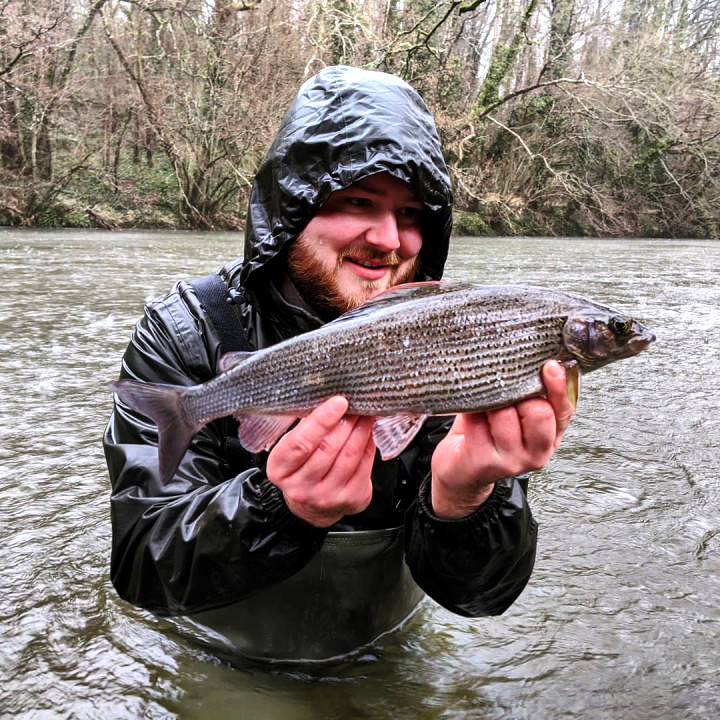 Cefnllysgwynne - PB from Leicester
Cefnllysgwynne - PB from Leicester When the trout season opened our keenest anglers were out first, as you might imagine. JA of Leominster visited his favourite Edw and found the narrow road up the valley partly obstructed by tree falls and landslips. On the 5th NH of Bristol tried the Usk above Brecon at Fenni Fach, found large dark olives hatching during the early afternoon and managed half a dozen trout on emerger patterns. Although the water must have been very high, the large dark olive is just what we look for in March and this must have made a very satisfactory start to the season. On the 7th MH of Llandrindod Wells decided to have one final try at trotting high water for grayling at Builth Wells. Maggots are not allowed here in the last days of the coarse season, so MH used a tin of sweetcorn and was pleased to catch a mixed bag of 6 grayling to 2 pounds 2 ounces along with a chub and a couple of trout. I will admit that the sweetcorn experiment is not one I have tried on Wye grayling, but I know it is a very popular bait on the upper Severn.
River banks look quite battered now as they emerge from a winter of floods and the Foundation’s webcams have not been spared. Regular gauge watchers will be familiar with the camera which is knocked off aim, so that we get a view of a grassy field rather than the board with its markers of inches and feet. So it remains until somebody visits and adjusts the camera again. Quite a bit more damage has been done this time and the Trostrey gauge has been carried away by a drifting tree. At such a time, it pays to have also a good understanding of the EA gauges, which record a graph rather than a picture and which many older anglers tend to use anyway. It’s worth getting into the habit of looking at both while doing your routine checks. On the WUF webcam page there is a link to a sight called Shoothill which enables easy location of the EA gauges.
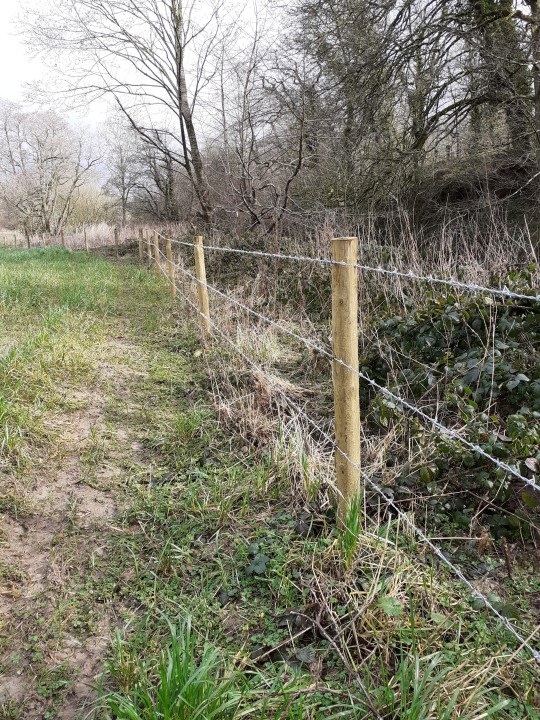 New barbed wire at Kington - JA from Leominster
New barbed wire at Kington - JA from Leominster 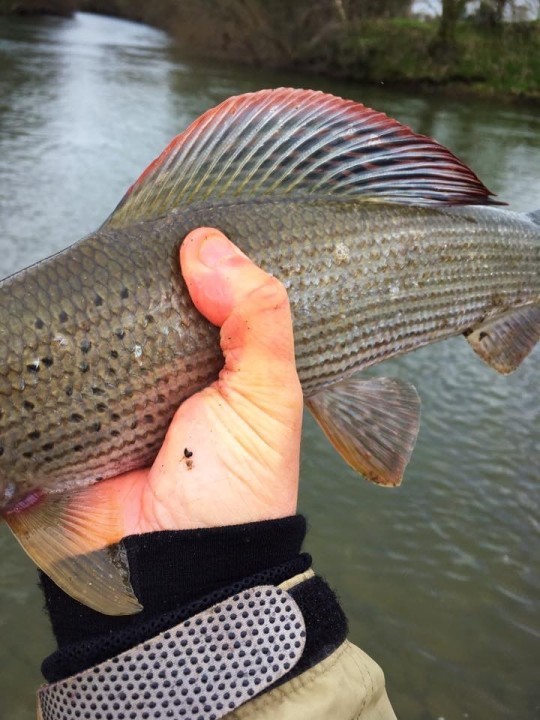 Builth Wells graying - MH from Llandrindod Wells
Builth Wells graying - MH from Llandrindod Wells 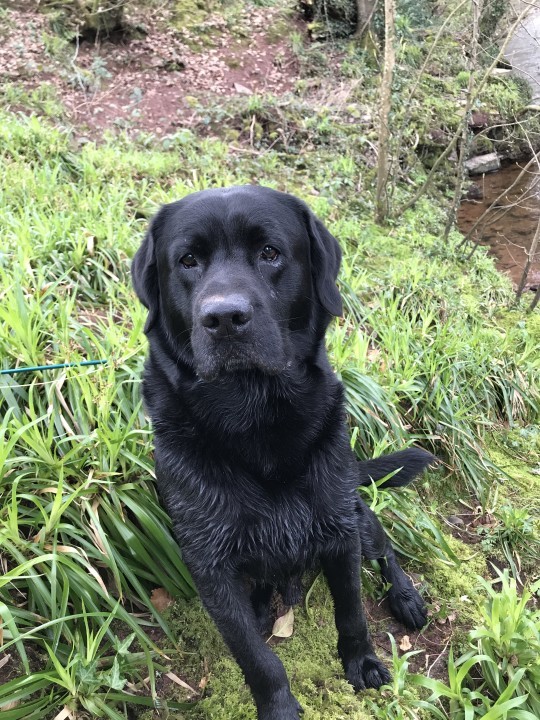 Penpont labrador - AM from Romsey
Penpont labrador - AM from Romsey While the water was at least a metre too high for ideal fishing, the Ross Angling Club held a familiarisation day for new members. I did appreciate this effort from Chairman Trevor Hyde with colleagues and wish that other clubs and syndicates would take so much trouble for newcomers – it is a rare courtesy, unfortunately. Ross AC have 5 miles of the middle Wye and we walked the whole of it in both directions, during which we were shown practically every place in which salmon have been taken, or even known to lie or show, in living memory. One or two members were out spinning from the banks and, although the water was high, it was running clear and possible for us to get an idea of the character of the flow. We were told something about every run or pool and while the unloading of memories from decades past might indicate the years of plenty which are no longer with us, there was also fresh information available from last season. It was a reminder of the adage that local anglers catch most of the fish and that gadding around from river to river after salmon and sea trout – we have all done it – is a poor substitute for getting to know one fishery really well. There was more fly water than I expected and I was also surprised to learn how many sea trout have been taken on club waters.
A few brave coarse fishermen took advantages of the remaining days of their season and high water barbel were taken from the middle Wye. However, the rivers reacted quickly to yet another round of storms on the night of the 10th and all the rivers came up again into flood. As everybody understood, by this time the saturated land had no capacity for absorption of additional rain. Everything that fell went straight to the rivers. So the month continued for quite a while; every little shower sent the levels up again. For all that, angling effort was made. On the 13th NM from Corbridge fished the Usk at Ashford House. High water ruled out most of the river, but in the margins he did manage to take 5 trout on a Hair’s Ear Emerger. They were “looking up” as he put it. On the 14th LE from Usk managed 3 trout up at Pantysallog. Next day AW from Ammanford had 4 trout from the Usk reservoir, DP from Neath also had 4 on the Blob from the same water. Llwyn On produced 8 trout for LH from Pontypridd with a friend, fishing with worm on the bottom. JA of Leominster went to fish the Arrow at Kington, describing the water as “high and clear.” He caught a couple of small trout on nymphs but was disturbed to find new three row barbed wire fencing blocking him from the river at the lower end just above the bridge. Why no crossings provided for anglers, JA wanted to know? In my experience anglers and their needs tend to be forgotten about when fencing contractors get their instructions from landowners, but it would be nice if this could be rectified. MH from Llandrindod Wells finished the grayling season off with another day trotting sweetcorn at GPAIAC, Builth Wells. The Wye was running cloudy and the gauge showed 1.8 metres, so that it was only possible to fish the slacks, but he took 5 grayling, one chub and a dozen trout. I was in Sussex for a couple of days and noticed that the Arun, Rother and Ouse were all high and muddy still.
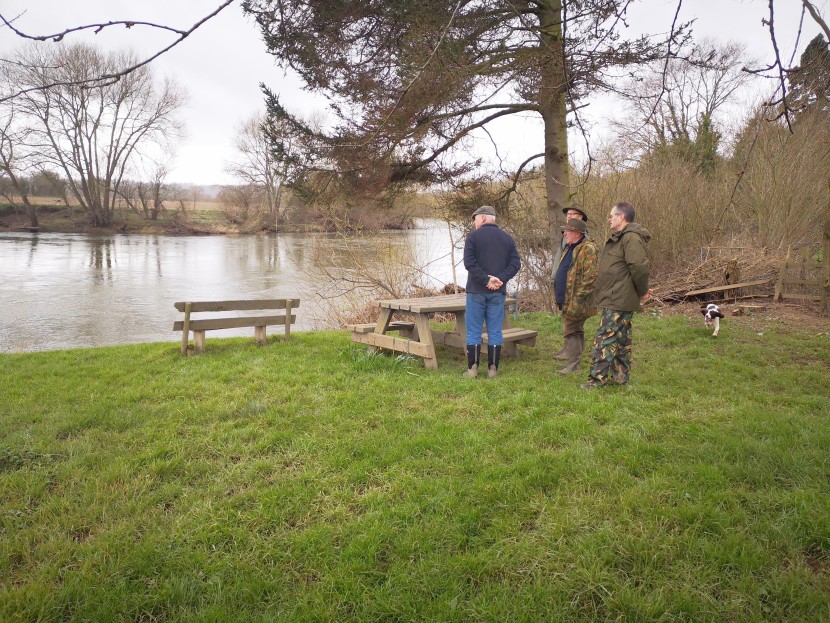 Inspecting the river at Ross
Inspecting the river at Ross 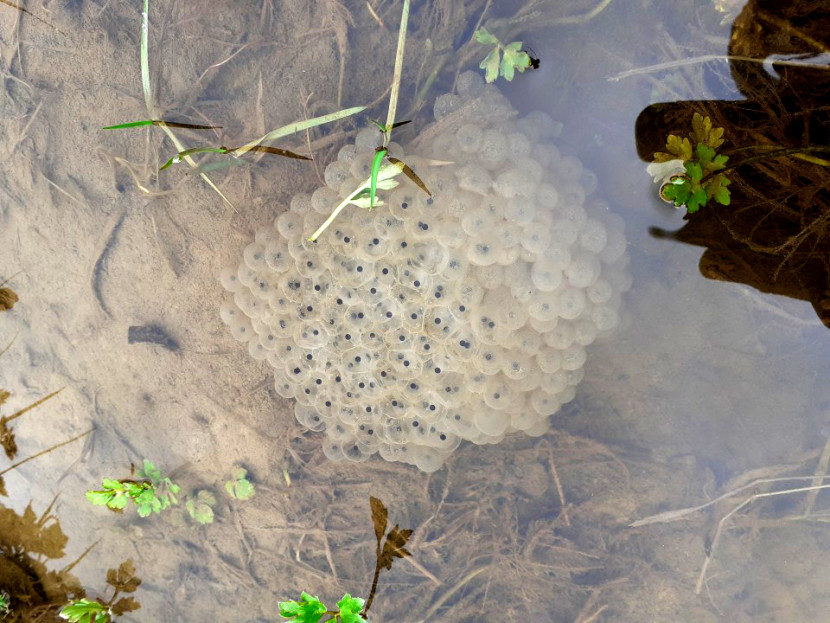 Frogs know it's spring - JA from Leominster
Frogs know it's spring - JA from Leominster 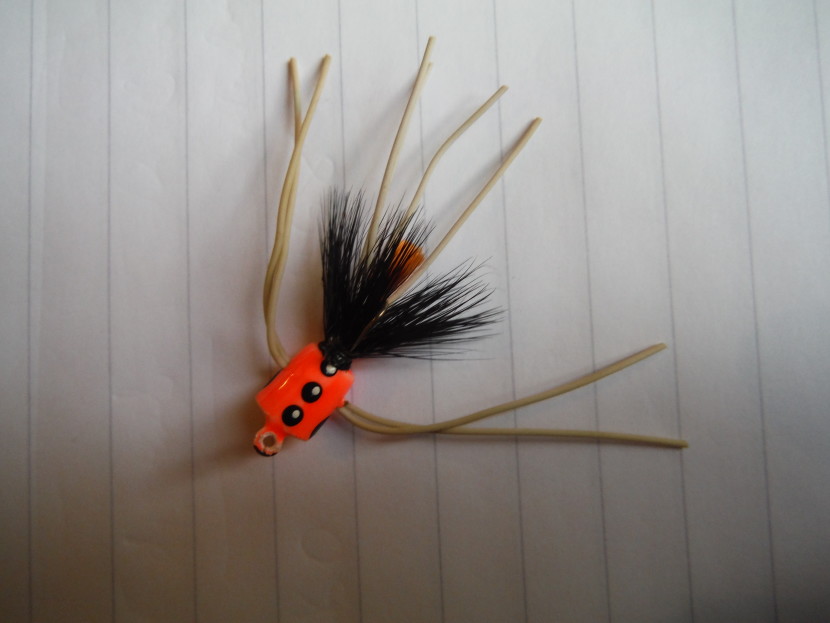 The beast
The beast While the rivers and streams continued to be off limits due to high water, along with others I went fishing for rainbows in ponds. The Woolaston Court fishery, open and windswept near the Severn estuary, has always been what I call a buzzer water. This spring the buzzers were very small and there has also been a good deal of fishing pressure. As a result, in order to get regular takes I found I needed to fish three tiny patterns round across the wind on a floating line. These were Black Speck Nymphs tied on size 18 hooks, flies which are truly microscopic, but capable of holding a bad-tempered rainbow or tiger trout quite securely with a bit of care and a light rod. Over on our Forest syndicate pool, which is not so much of a buzzer water, we have not stocked since the autumn. Numbers of fish are therefore relatively reduced, but those remaining have overwintered beautifully. Slightly to my surprise, the other day I found quite obvious and visible fry feeding involving small roach of two or three inches long. Using the autumn tactic of an intermediate line to fish an unweighted white lure such as an Appetizer or a Cats Whisker proved to be deadly. It was just a matter of casting into the general area of interest and allowing the fly to sink, strip-striking when the line began to tighten. I returned half a dozen fish this way one morning and was thinking of making for home and lunch, when I noticed some odd swirls or rises right in the margins by the new spears of yellow flag iris. I thought it might be a dab-chick, but the little bird never appeared at the surface. Surely not a trout - rainbows do not behave in that way. And then there was a swirl and a gulp right next to me and I saw what it was: two mating frogs, the smaller male clenched tightly to the larger female’s back. I don’t know which of the two decide when it is time to interrupt the love-making to take a breather, but it must be necessary at intervals.
At this point I remembered a fly which somebody gave me a few years ago, probably as a joke. It had been lying in one of my boxes ever since. I think this was originally intended as a freshwater bass lure for use in the USA, a sort of popper or surface lure. A buoyant orange plastic drum is painted with eyes, there is a circular hackle at the back and a series of long rubber legs. I imagine it might be intended to imitate a small frog. Or could it be a crab or even a tarantula? The worst thing about it is the hook, a narrow gape size 12 lashed to the bottom of the drum. In a whimsical mood now, I went to get this thing which I will call The Beast from the car, tied it on the leader at the end of the intermediate line and launched it out into the ripples in the middle of the lake. I surmised there would be a good few seconds before it sank. However, I never did find out how long it would take for the line to pull it under because within a couple of seconds a hefty rainbow erupted completely from the surface and smacked down on top of The Beast. It was a truly spectacular surface attack, reminiscent of a great white shark pouncing on a seal or a surf boarder. Unfortunately, when I tightened after a couple of seconds there was nothing there, although I half expected to see a blood stain and a torn swimmer’s lilo. That rotten little hook had totally failed to catch on. Nevertheless, I tried the same cast again and twice more provoked the same dramatic response from trout which came right out the water to make their attacks from above. Nothing was hooked, but I can imagine future experiments after constructing something similar to The Beast with foam rubber or deer’s hair and rubber legs, perhaps on a long shank size 6 hook. On a later visit, a bright day with a cold wind, I found small black midges hatching in a cold ripple. There were not many rises going on, but I managed to catch three rainbows with a size 14 dry buzzer pattern and the takes were very confident.
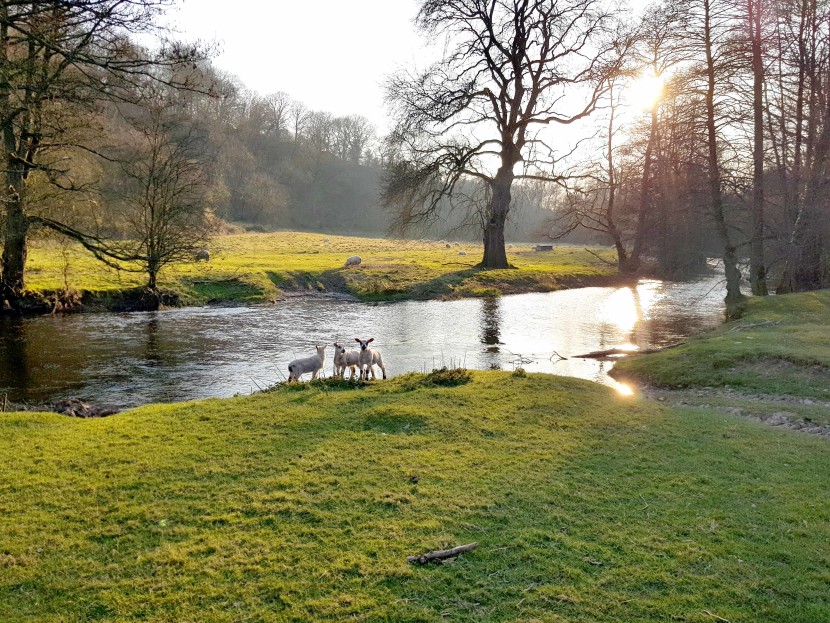 March lambs beside the river Arrow
March lambs beside the river Arrow 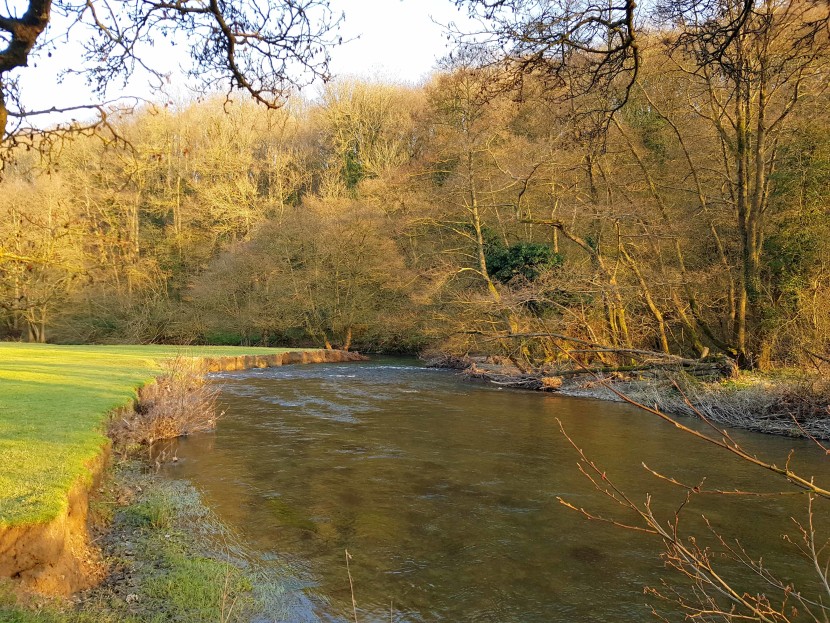 The Arrow
The Arrow Believe it or not, the April edition of Trout and Salmon contains no less than 28 beautifully illustrated trout fly patterns, nearly all of them new ones to me. There was once a time I would have greeted that lot with a chuckle of anticipation and sat down to tie at least three in each size of all of them, just to see what they might do for me. I have calmed down a bit since then, but that past enthusiasm for new patterns explains why I now own so many flies which I never or rarely ever use. It also explains why I have so many fly boxes, far more than I could ever carry around with me. I should deal with the issue of fly selection and how many patterns you actually need for fishing on some later occasion, but for the moment, what can we say about fly containers?
Fly boxes are a little like coarse fishing floats, in that eventually both become regarded with inordinate affection by their angler/owners. All sorts of things have been used to hold fly collections in the past. The vintage tackle auctions sometimes include wonderful mahogany fly banks, almost like suitcases with sliding drawers, containing rows of carefully selected salmon flies and all labelled in order. The writings of Kelson probably encouraged such systematic collection and storage for the angler who felt he should have an example of every possible pattern. However, something more practical has always been used to take flies to the river. Oliver Kite, definitely a minimalist, used to keep his Sawyer’s artificial nymphs in little round plastic powder boxes which had been discarded by his wife. I can remember as a lad using the old Gloucester Match Company “England’s Glory” boxes to keep flies in, mainly because I liked the pictures of sailing ships on front. (According to legend there was a time when girl babies outnumbered boys by 5 to 1 in Gloucester and local folks blamed the match works). I think the first practical receptacle I had which resembled a proper fly box was a Player’s Navy Cut tobacco tin with foam rubber sheets glued inside. Tobacco tins were certainly common enough on the river bank in those pipe smoking and roll up days. Later in my fly fishing career there must have been a little more money around because I see that I began buying Wheatley boxes, the first of which was very sadly stolen along with other treasured possessions from my car in Spain. I have tried many different models since, but I am still not certain of what constitutes the perfect box for carrying flies – they all have their pros and cons. See what you make of this collection:
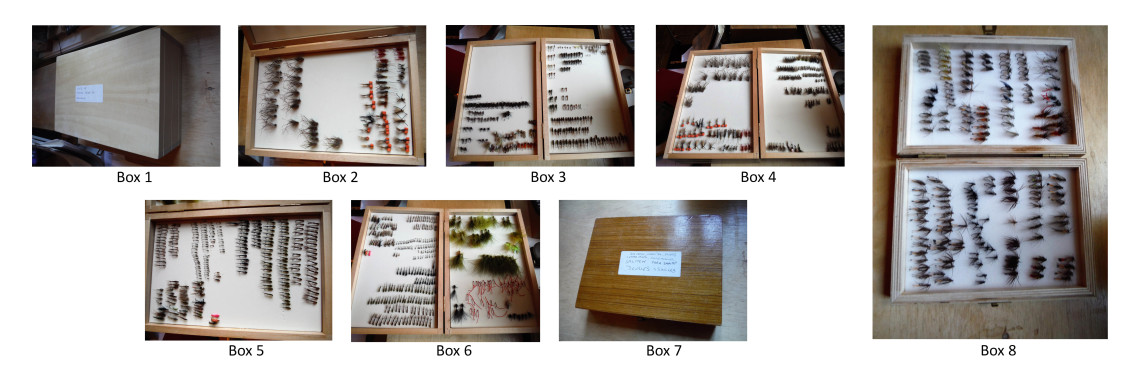
Fly boxes 1,2,3,4,5,6,7,8: These are all wooden boxes constructed in different sizes with brass hinges and catches, and come with two, four or six internal surfaces lined with foam sheet. These must have been around since the beginning of still water fly fishing. Only the smaller ones fit well in a pocket, but the larger ones are fine when placed on a seat in a boat. They are not waterproof and need to be kept out of the rain, but do at least float if inadvertently dropped in the water. In their defence, wooden boxes are relatively cheap, and represent a good value way of storing large numbers of lures, wet flies or nymphs. The hackles of dry flies will suffer if crushed against the foam however. The foam itself will eventually wear down through the constant insertion and removal of hook points and barbs, but replacement sheets for gluing in are available.
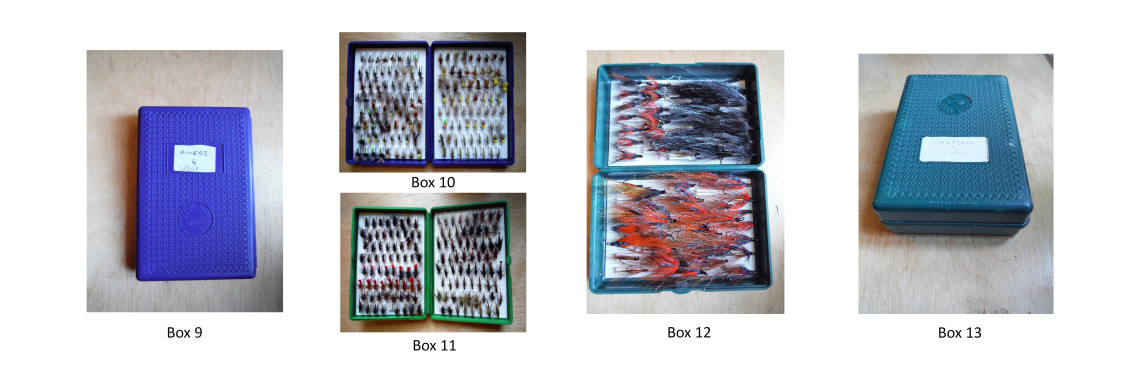
Fly boxes 9, 10, 11, 12, 13: These are the famous Fox boxes, formerly very popular. They were cheap, but not cheaply made, and very practical, being constructed of plastic with a sort of hard rubber interior lining with little raised ribs to grip the points of hooks by friction. There are two sizes of box with rounded edges, both of which fit in a standard waistcoat pocket. The deeper box for salmon and sea trout flies would certainly hold most of the usual sizes of double and treble salmon flies between 6 and 10, and the shallower box for trout and grayling flies is capable of holding 120 flies in sizes 10, 12 and 14…however note that the system does not provide a secure grip for larger than 10 and smaller than 14 trout flies. Nor are Fox boxes really suitable for dry flies with crushable hackles, although wet flies and nymphs live in them very happily. A range of colours – red, black, grey, two shades of blue and two shades of green - were available so that the angler could quickly recognise and grab from his collection whichever box he needed without looking at the label – although there is space for a label. They are not waterproof and do not float for long, but are otherwise pretty well indestructible. After a period off the market they are available again from something called The Great British Fly Box Company – I love that name!

Fly boxes 14, 15, 16, 17: The classic Wheatley fly boxes go back to the 1860s and are still available today, although at much higher prices in real terms than we paid fifty years ago. They consist of aluminium boxes with very close engineering fits, little dry fly compartments with spring-loaded transparent lids, and inside the opposing lid a system of clips to grip the bends of wet fly or nymph hooks. Some of the modern ones have a sheet of foam rubber as an alternative mounting for the wet flies. They protect dry flies very well, provided you do not overfill the compartments. Polished aluminium tends to rub and scuff which means that the patina of the outer box is always very interesting; the older they get, the better they look. They are not water-tight.
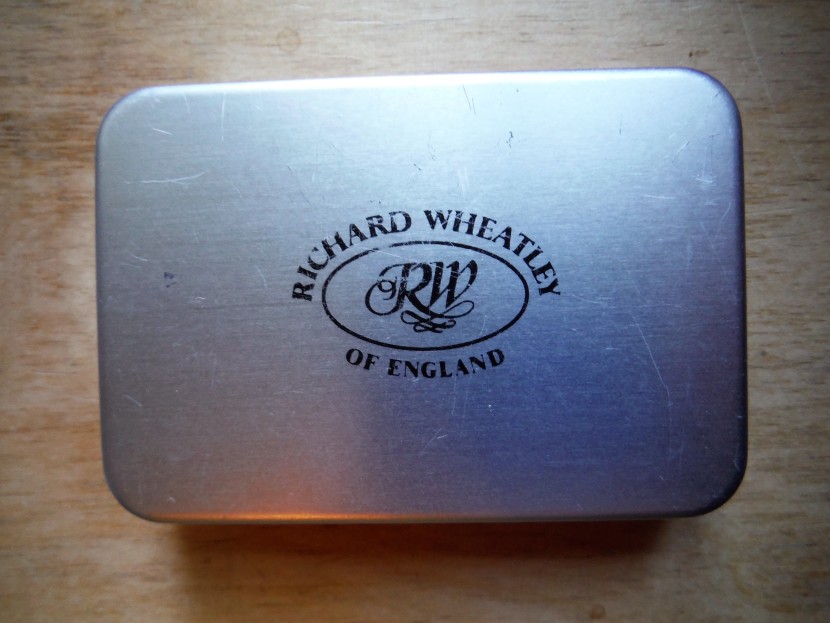 Box 18
Box 18 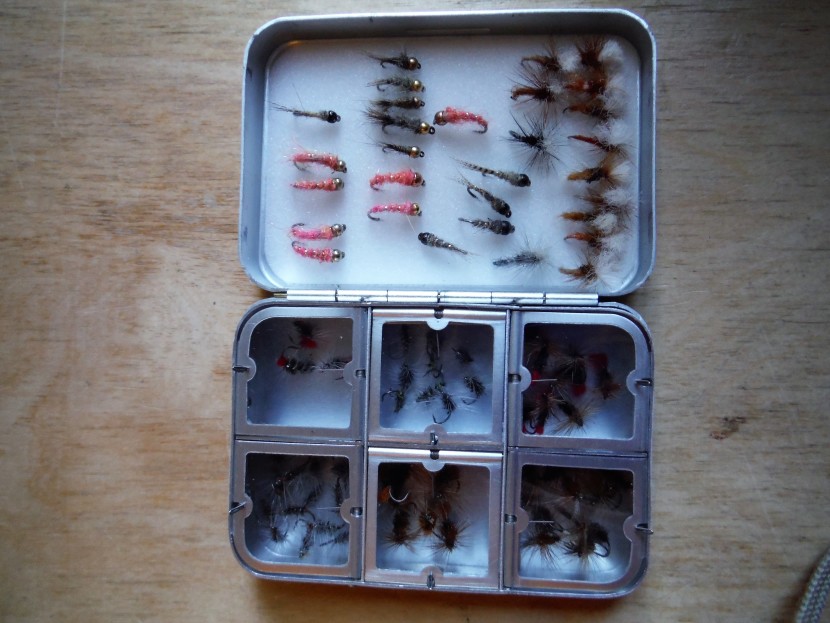 Box 19
Box 19 Fly boxes 18, 19: Minimalists will like this one. It is a modern Wheatley box in the smallest available size, containing a range of dry flies and nymphs suitable for autumn grayling. For a day of grayling fishing, it’s all you need in your pocket apart from leader materials.
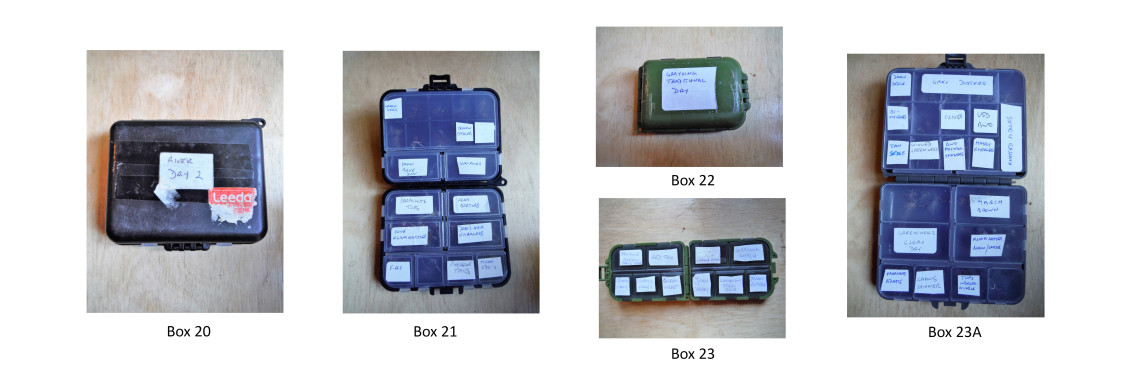
Fly boxes 20, 21, 22, 23, 23A: These little plastic boxes with compartments are available from most coarse fishing tackle shops and I think are intended, not for flies, but for odd items like split shot, weights, swivels, rubber sleeves etc. However, they are rounded to fit in the pocket, extremely cheap and do well enough for small dry flies, even if not water tight. These came from Yorkshire Game Angling.
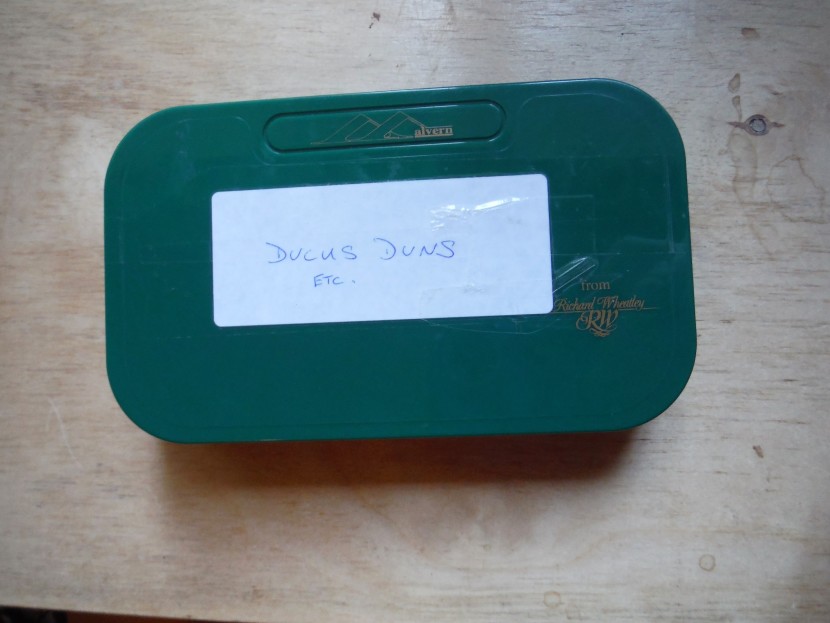 Box 24
Box 24 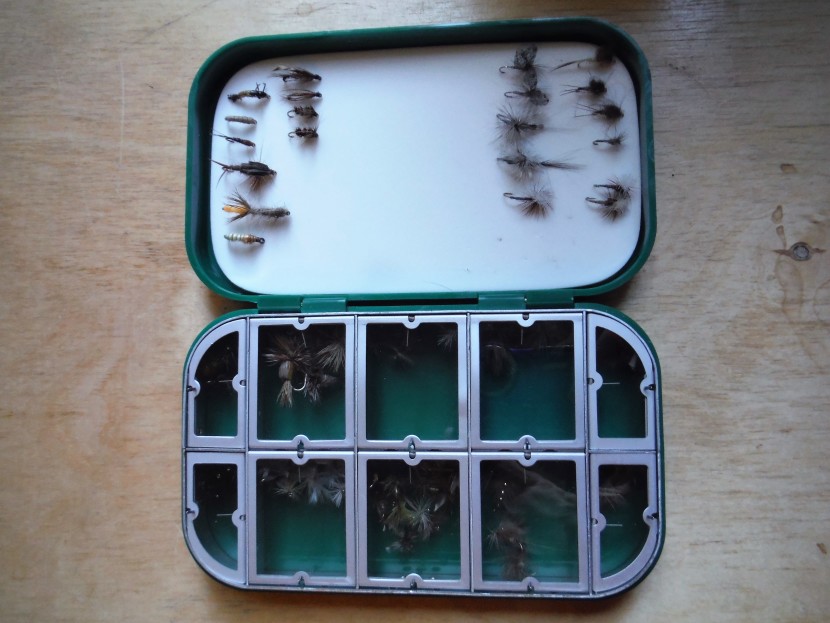 Box 25
Box 25 Fly Boxes 24, 25: This is the “Malvern” model of Wheatley fly box, in which money was saved by making the main case out of hard plastic rather than aluminium. Otherwise, everything else is the same. I am not sure why the model is not more popular because it is very tough plastic and I have never known one crack.
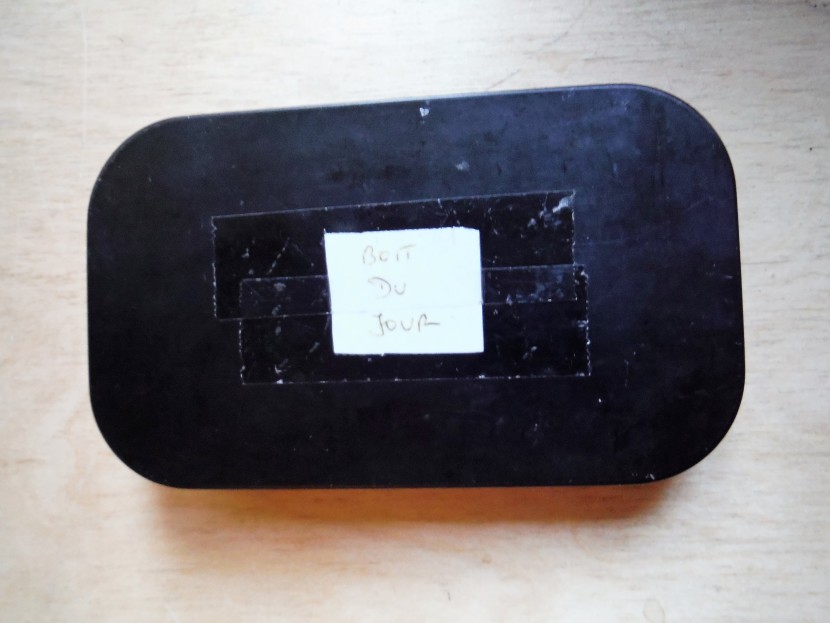 Box 26
Box 26 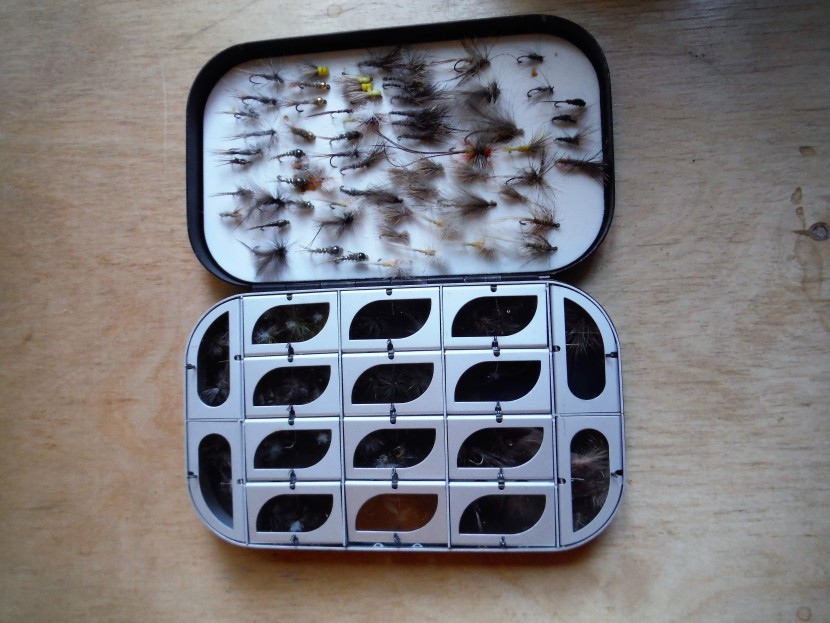 Box 27
Box 27 Fly boxes 26, 27: You do see some very close copies of the Wheatley box on the market and this is one. Almost the same, but not quite.
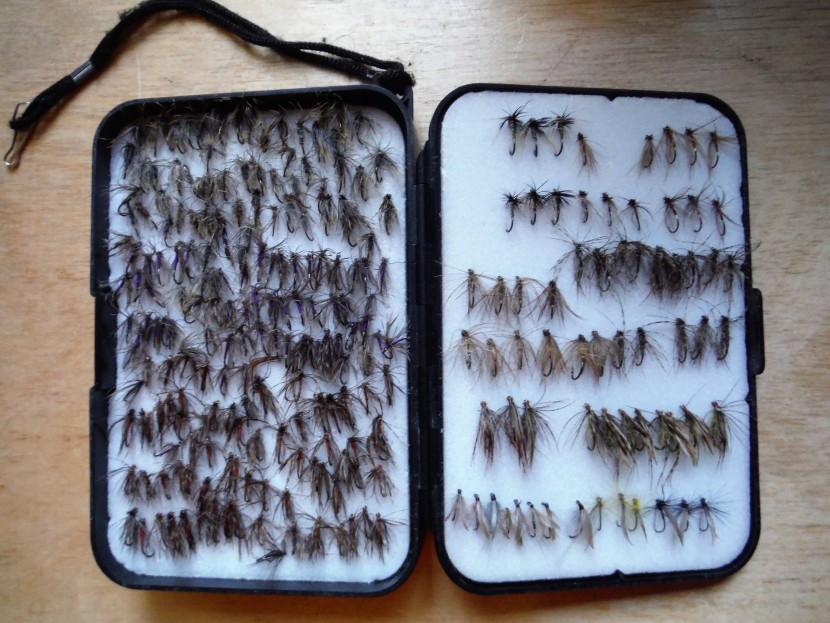 Box 28
Box 28 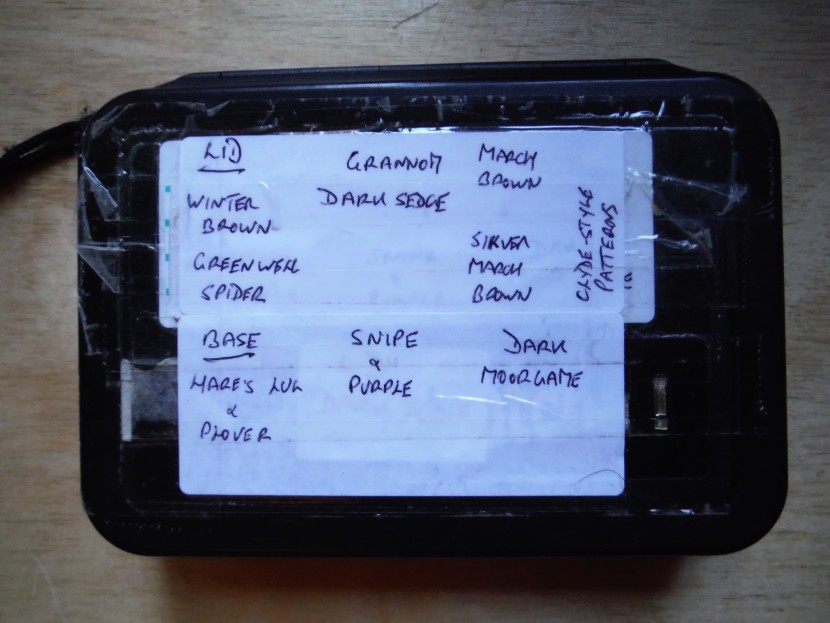 Box 28A
Box 28A Fly boxes 28, 28A: A cheap and cheerful plastic box fitting the pocket with an extra leaf inside and foam linings. It isn’t waterproof but it does have a small lug for attaching a lanyard in case it is dropped. I find it a practical working box for holding spiders, mostly in size 14 and 16.
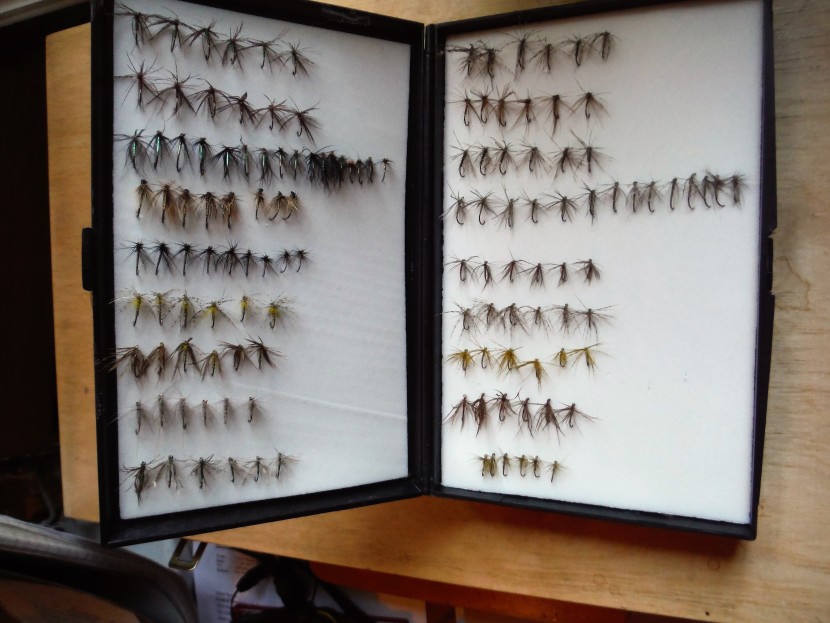 Box 29
Box 29 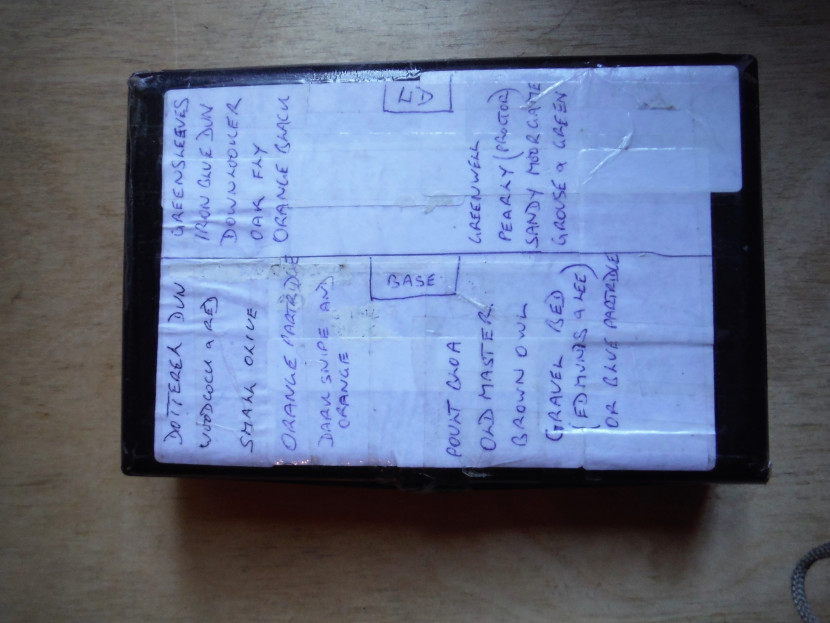 Box 29A
Box 29A Fly boxes 29, 29A: Another plain plastic box with interior leaf. This one, unfortunately, is too big to fit in most pockets, so rather impractical. I use it for keeping sample patterns of spiders.
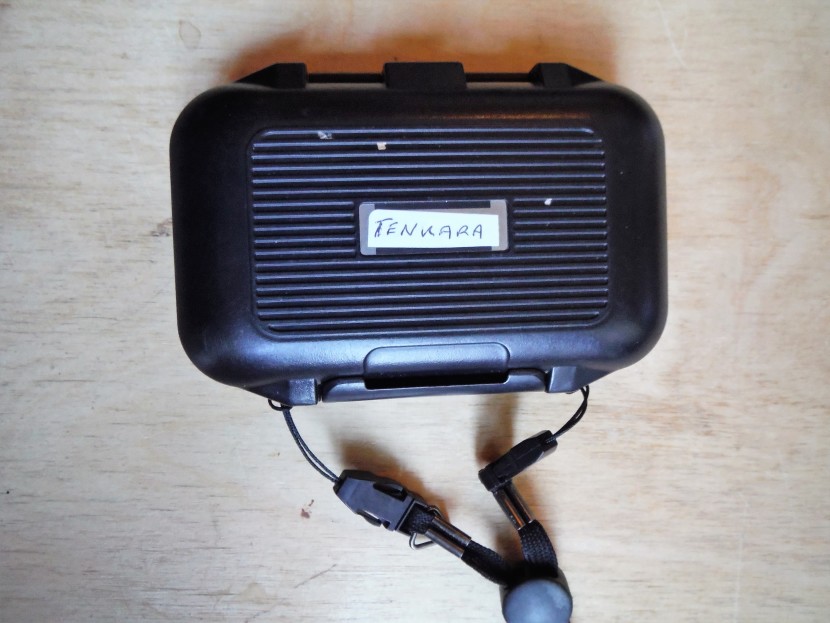 Box 30
Box 30 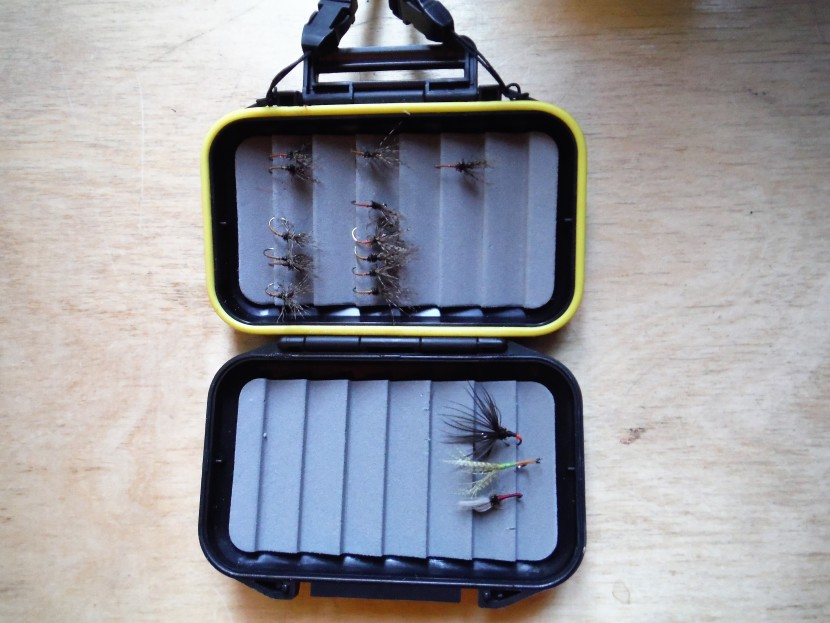 Box 31
Box 31 Fly boxes 30, 31: This is a small waterproof box with ripple foam interior which comes with a lanyard and is designed to be worn round the neck. This particular one holds Tenkara flies.
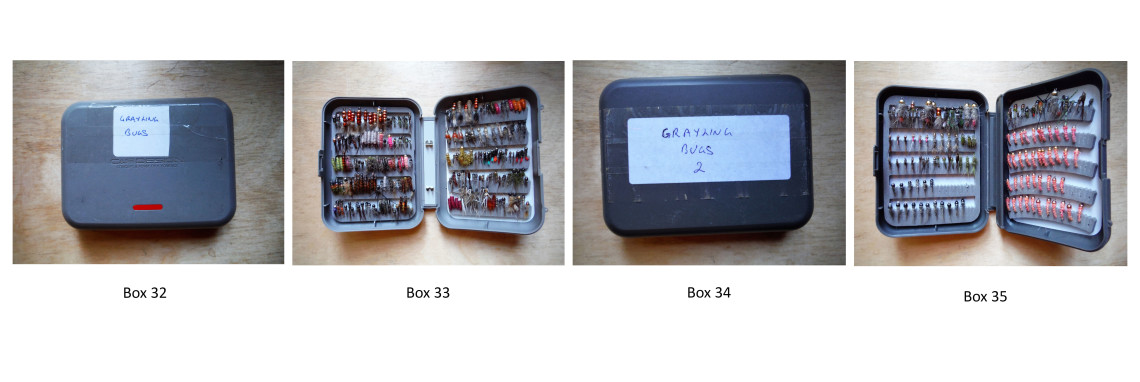
Fly boxes 32, 33, 34, 35: This is a small modern box from C&F Design. It is another with a smooth, rounded shape and the flies are held by friction in slits in a foam pad which, theoretically at least, should never wear. There is provision for colour coding on the outside of the grey plastic box and lugs for a lanyard. Not waterproof and suitable for nymphs or perhaps wet flies, but not dries. There is also a specialised tube fly version which goes sewin fishing with me. It has separate compartments for double and treble hooks.
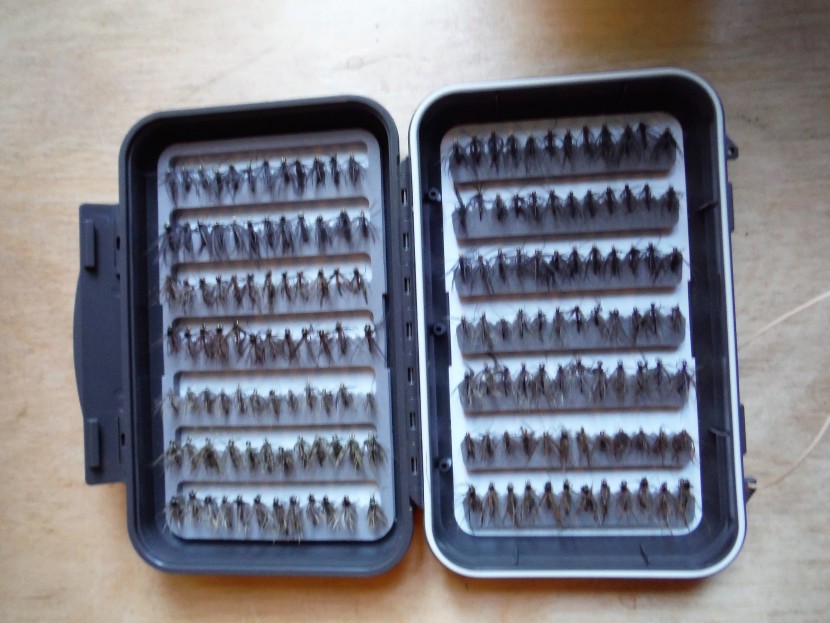 Box 36
Box 36 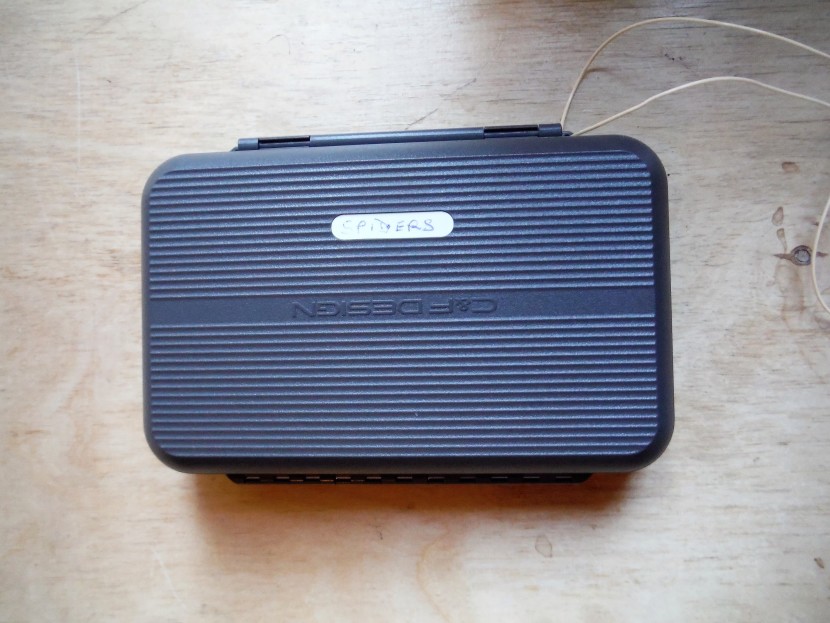 Box 36A
Box 36A Fly boxes 36, 36A: C&F Design’s medium sized box, still pocket-sized, holding flies in the same foam slits. Again there are lugs for a lanyard and this time the design includes a rubber seal, so that the contents will not get wet if the box goes into the water.
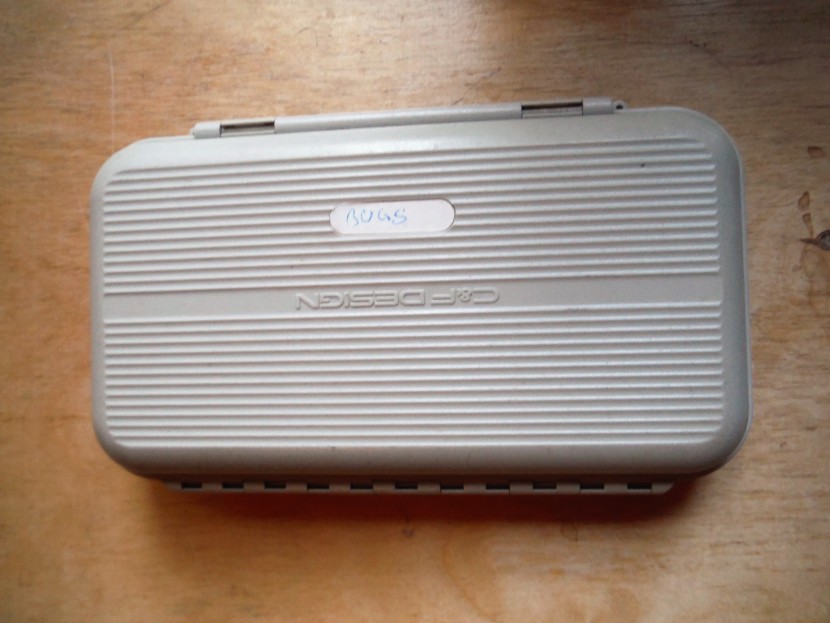 Box 37
Box 37 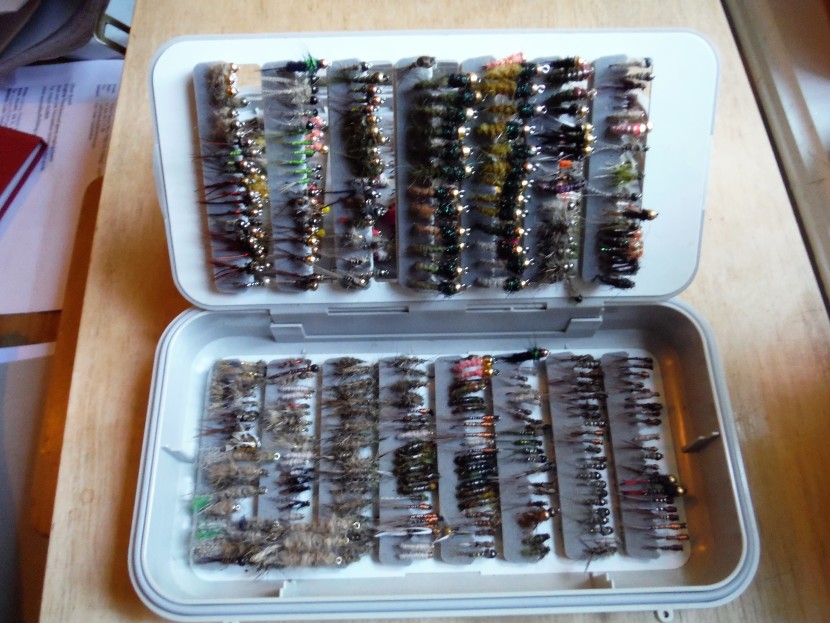 Box 38
Box 38 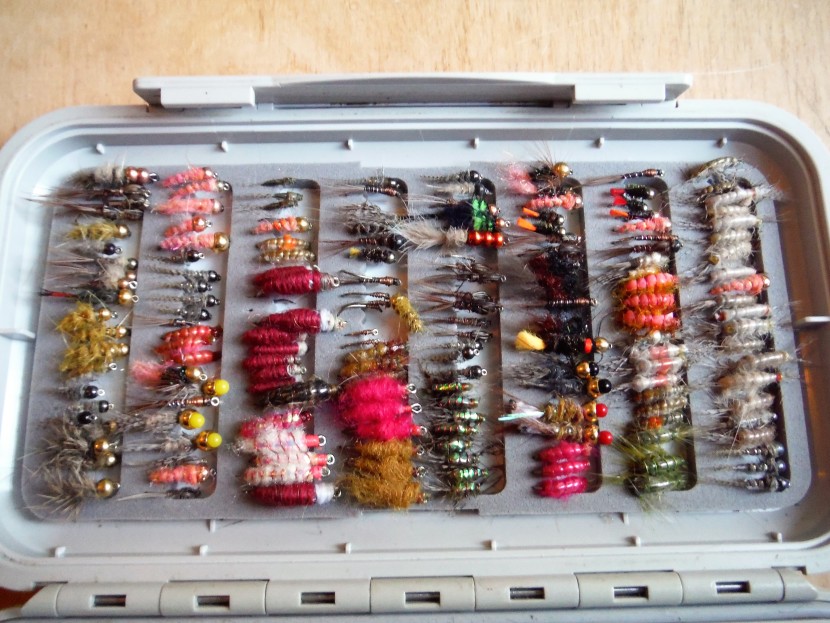 Box 39
Box 39 Fly boxes 37, 38, 39: This is the large C&F slit foam box, apparently huge with an enormous capacity for flies due to an internal leaf, but to the surprise of many it still fits in a standard vest pocket. Lugs and a watertight seal are included.
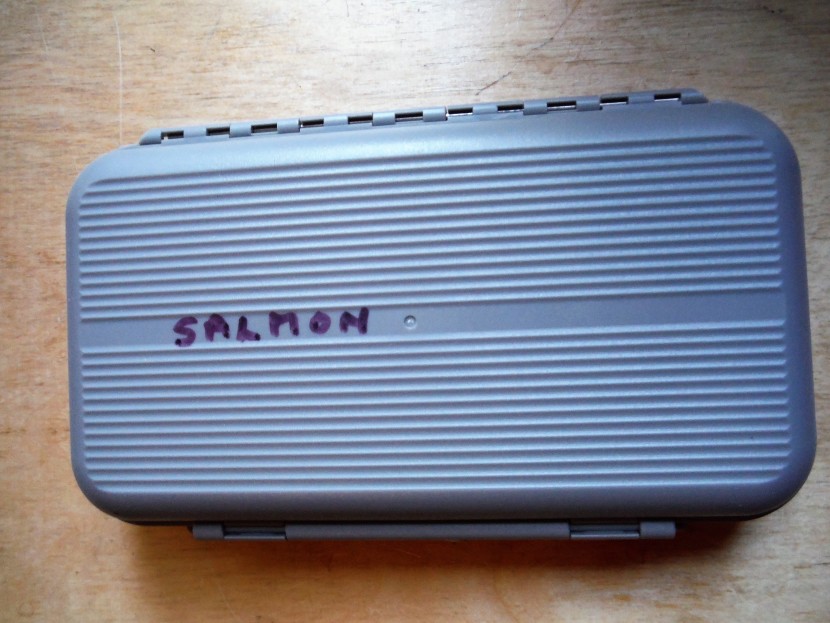 Box 40
Box 40 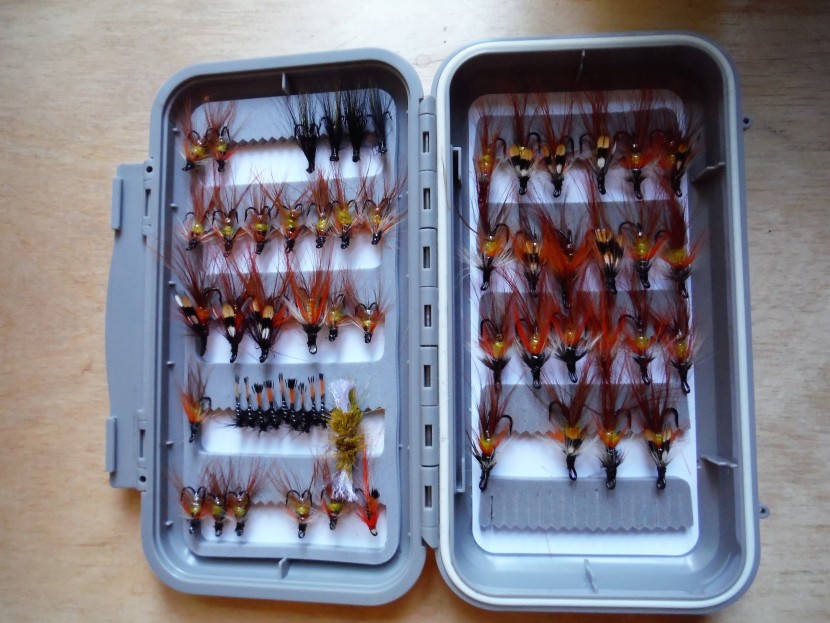 Box 41
Box 41 Fly boxes 40, 41: Here is the salmon version of the large C&F box and it accommodates conventional salmon doubles and shrimps with ease.
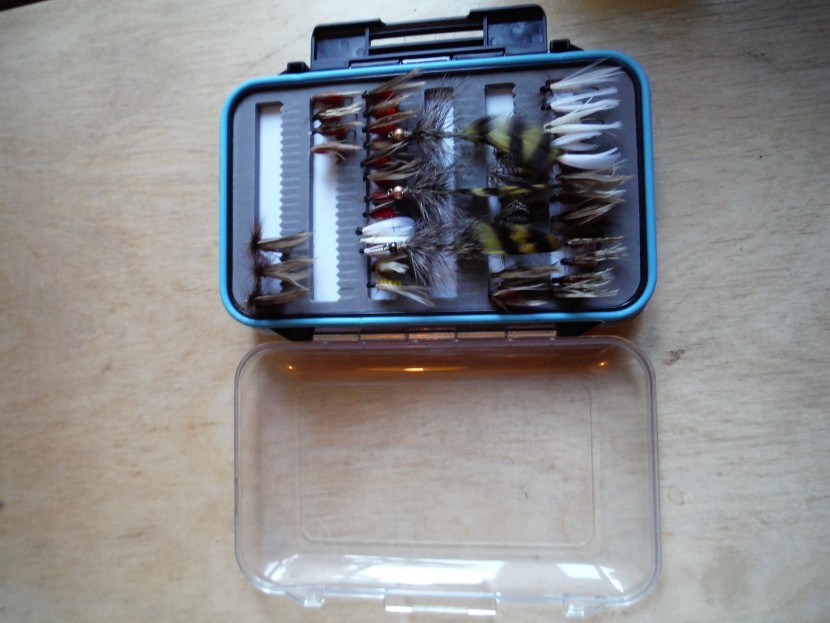 Box 42
Box 42 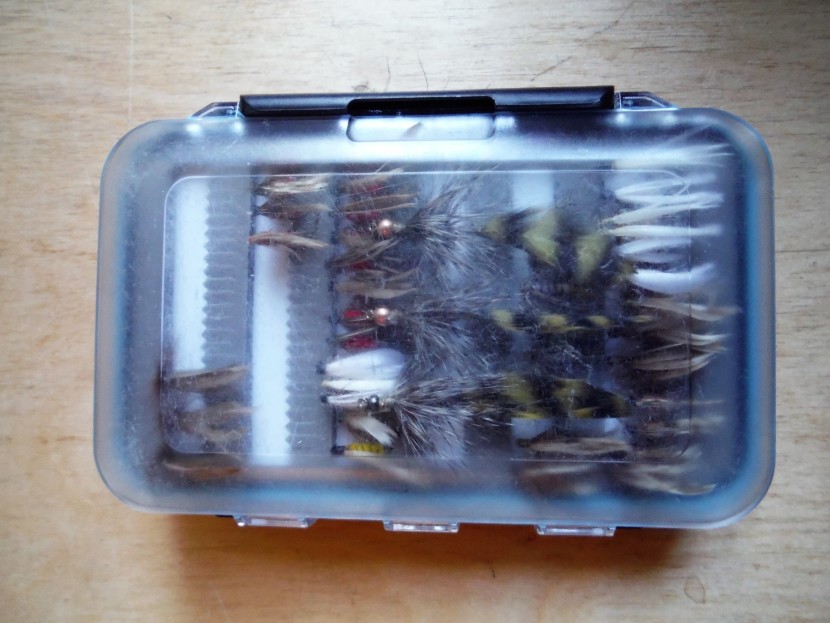 Box 43
Box 43 Fly boxes 42, 43: This design of “clear view” fly box has been fashionable lately, but I can’t understand why. It is quite a deep box with rounded edges and the flies are mounted on either side of an internal leaf or flap. The lids, on the other hand, carry no flies on the internal faces and are made of clear plastic so that you can see inside. What a waste of space! If you need to know what is inside you could always put a label on the box or identify it with a dab of paint.
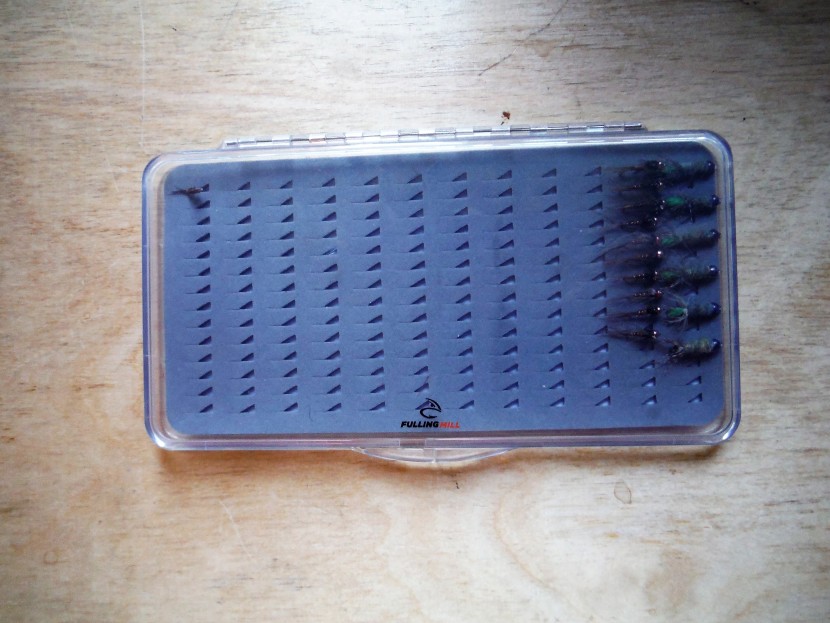 Box 44
Box 44 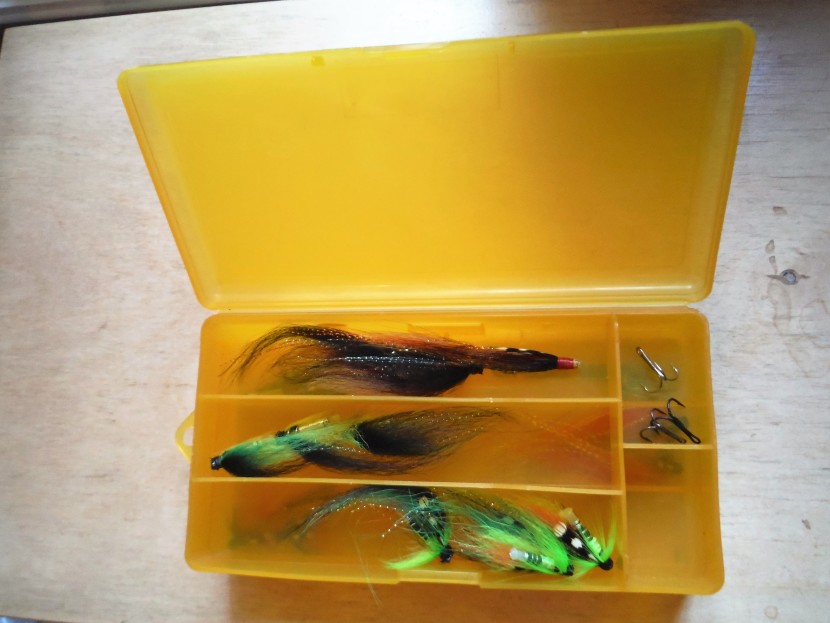 Box 45
Box 45 Fly boxes 44: This slim-line design by Fulling Mill, on the other hand, does make sense. It carries just one layer of flies in its slit foam because the box with its clear plastic lid is extremely shallow. However, because each box is as slim as a cigarette case, it’s possible to get four or five of them into one waistcoat pocket. It is only really suitable for nymphs due to the lack of internal space…but that accords quite well with the direction of modern angling! Not waterproof.
Fly Boxes 45: A plastic box, I think by Michael Frodin, designed to hold modern long-tailed salmon flies and tubes.
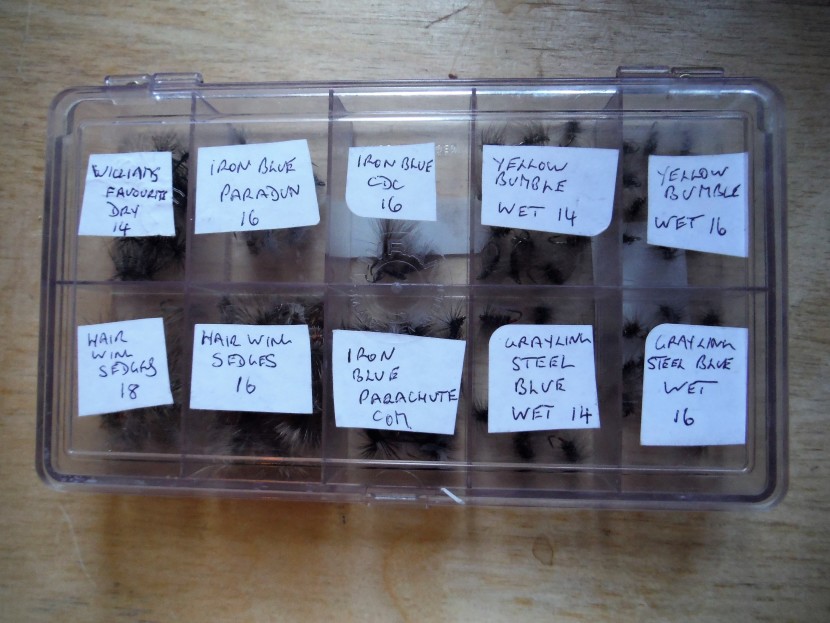 Box 46
Box 46 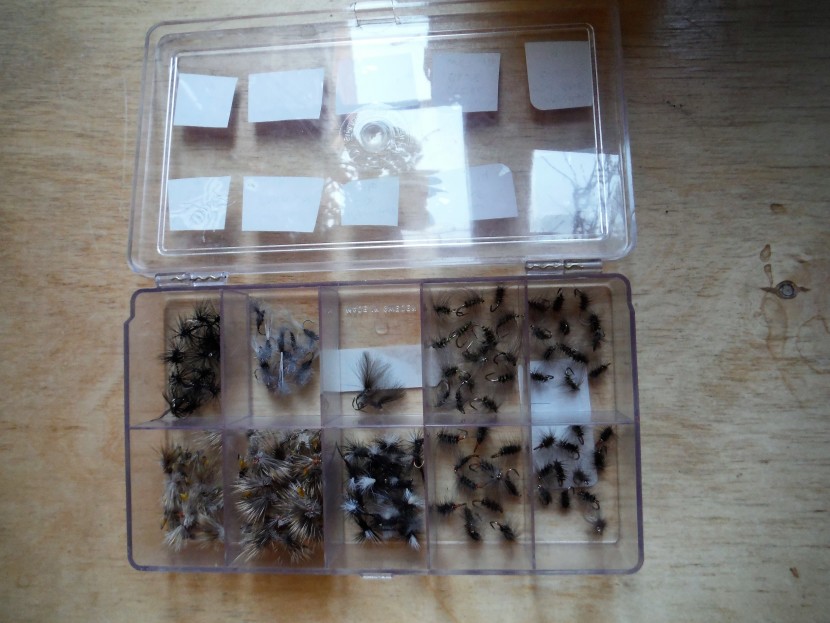 Box 47
Box 47 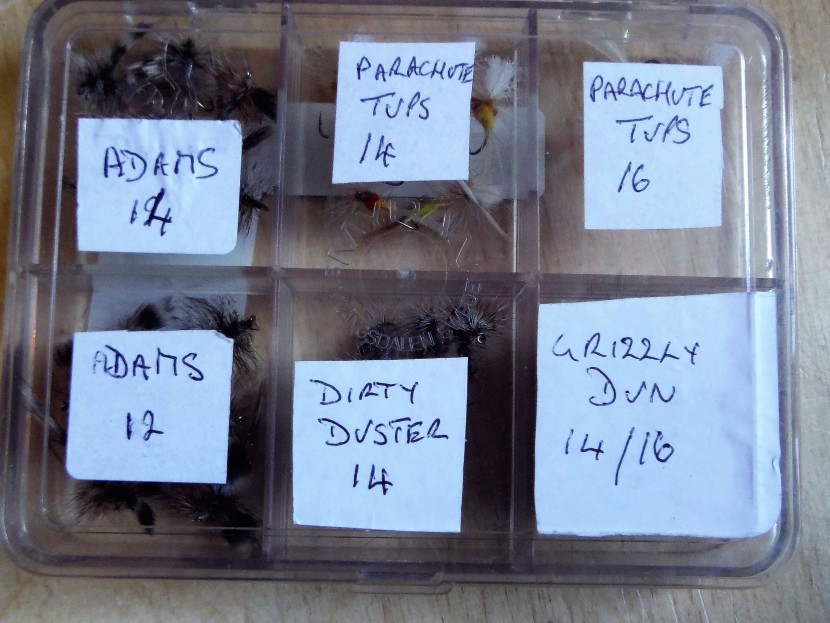 Box 48
Box 48 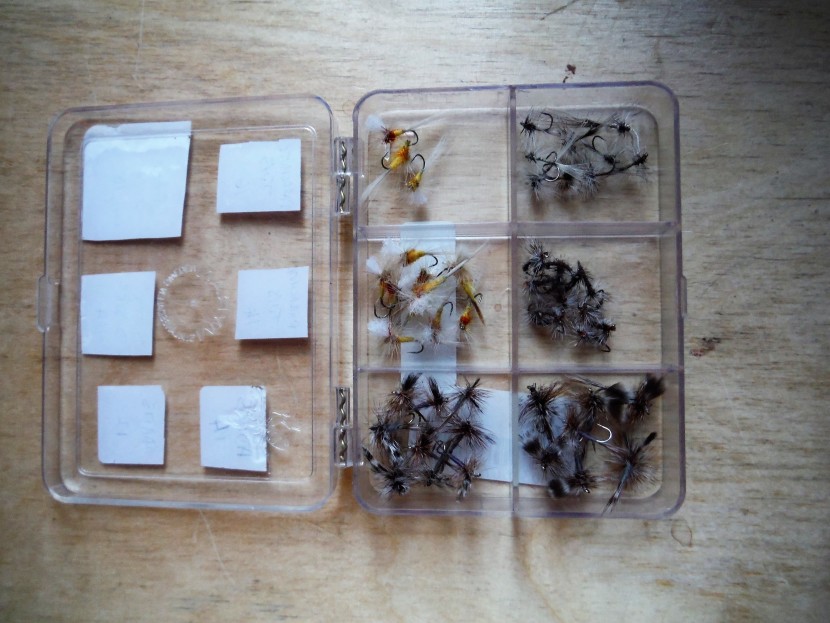 Box 49
Box 49 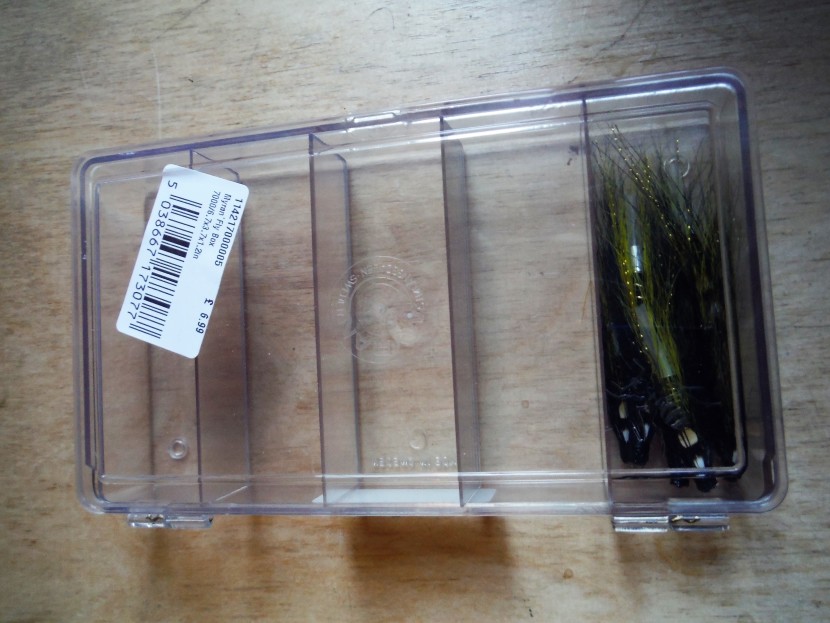 Box 50
Box 50 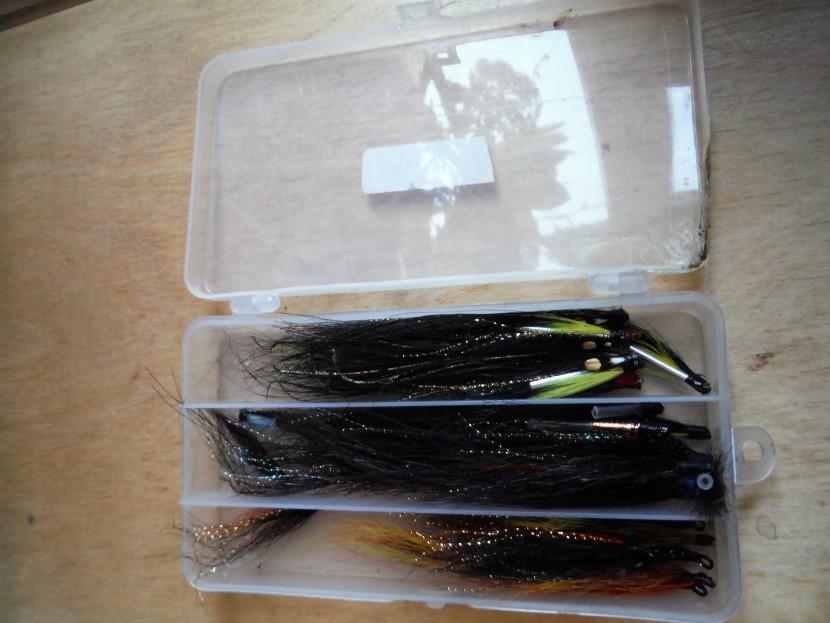 Box 51
Box 51 Fly Boxes 46, 47, 48, 49, 50, 51: These are Myran boxes from Sweden made in a very tough, clear plastic at a reasonable price. They are available in a variety of sizes, either to carry in the pocket or to stack up inside a cabinet, and with a range of different compartment sizes. Thus tiny dry flies or large mayflies can be protected, but there are also long compartment versions which will deal with tube flies or long salmon patterns like Collie Dogs or Sunray Shadows. Not waterproof, but certainly very practical; I have lots of Myran boxes which I use for my main warehouse storage and reserve supply. Most of them live stacked in the foam-lined interior of an old film camera box in the office, but I take them fishing sometimes too.
General points: The advantages of a water-proof fly box can be overstated. Of course if you wade deep and keep the box in a lower pocket of your wading jacket, you are at risk of getting the flies wet. You could use a breast pocket or keep the box on a lanyard round your neck and tucked inside the waders. Some of those who like to get in up to their armpits like to tuck the whole vest inside the waders. The important point is that if the interior of the box does get wet, dry it out as soon as you get home. Leaving it open on a warm shelf overnight should do the trick. Similarly, never cut a damp fly off the leader and put it straight back in the box. At the very least you will get a rusty hook-point and you may very well spoil the whole box in time. Instead, put it to dry on some kind of patch, ideally one of the fold-over sheepskin type and a few hours later it will be ready to go back in the box. Of course it’s a mistake to stuff your jacket with a myriad of fly boxes “just in case.” However, it’s a mistake I’m very prone to making myself. Ideally a single fly box should hold all that you need or are likely to experiment with on the day, and you restock it as and when necessary. Thus your working fly box becomes a day box which the others will feed into. This is a nice idea at least and one I plan to adhere to at some future date. And of course you should rearrange the contents of all fly boxes now and then. In a francophone moment I once labelled a Wheatley box for spring fishing on the Monnow La Boite du Jour. It was a complete muddle last time I looked in it.
Here are the answers to last month’s little quiz about the Lawrence of Arabia movie and those unlikely references to fishing:
1. Peter O’Toole’s Lawrence, exhausted physically and mentally after crossing Sinai to announce the capture by Arab irregulars of the Red Sea port of Aqaba, reaches the Suez Canal and is taken with his young Arab companion to British Army headquarters in Cairo. (For the movie, the headquarters building and complex is represented by the Plaza de Espana in Seville, which was built for the 1928 Spanish-American fair. Presumably this was chosen because nothing looking so superbly oriental can be found in Cairo). General Allenby, commander of British forces in the Middle East (played by Jack Hawkins), takes Lawrence, his liaison officer Colonel Brighton (Anthony Quayle) and political adviser, Dryden (Claude Rains), for a celebratory drink in the officer’s mess. There the four of them gather around a courtyard fountain discussing plans for a campaign of irregular warfare to be waged in Arabia. The talk turns to the post-war future of the Ottoman Empire, but we see that Allenby, even while he talks, is slightly distracted and not by the glass of beer at his side. The fish in the fountain (although we cannot see them) have caught his attention, and he tries feeding them with pieces of biscuit.
2. Lawrence and the Arab Army have beaten Allenby by 24 hours to occupy Damascus. The main Allied force arrives and Allenby, Brighton and Dryden settle into new quarters. Allenby’s plan is to take over control of the city as and when the new Arab administration fails. Meanwhile they wait and British technical units are kept in barracks. “We can’t just do nothing,” somebody says. “Why not?” responds Allenby. “It’s usually best.” Exchanges like that are writer Robert Bolt at his best. A scene opens with Allenby perched on the edge of his desk practising casting rather ineptly with his swagger stick. A book is open in front of him, with a picture of a grayling visible. “I’m going to take this up after the war,” he says. And later: “It’s an old man’s sport.” “Are you an old man sir?” asks Dryden. Clearly it is a rhetorical question. The light goes out and they realise the power supply of the city has failed.
3. Near the end of the film, Lawrence appears in Allenby’s office to say farewell before leaving for England. Dryden, Colonel Brighton and Prince Faisal (Alec Guinness) are all present, and Lawrence has obviously interrupted a political argument about post-war arrangements for Damascus and indeed the future of the region. The atmosphere is now slightly forced and formal. Prince Feisal, tongue in cheek, begins one of his more flowery speeches suggesting that Lawrence must be homesick (and by implication perhaps no longer interested in Arabia): “He longs for the greenness of his native land; he pines for the gothic cottages of Surrey? Is it not? Already, in imagination he catches trout and engages in all the activities of the English gentleman.” Allenby eventually interrupts this flight of fancy: “That’s me you’re describing sir, not Colonel Lawrence.”
It would be nice to imagine that the actors came up with some of this themselves. It is said that director David Lean, never an easy man to work with, was much irritated with Jack Hawkins during filming. Hawkins, who had struck up a friendship with Peter O’Toole on set (and who by the way liked to go fishing with his family) often earned the director’s enmity by improvising lines. Might that independent streak have included the fish in the fountain and “I’m going to take this up after the war” with casting practice in examples 1 and 2? Actually, this was not the case as these details are all to be found in Robert Bolt’s original screenplay.
And who would have expected any reference to fishing in such a story? About as likely as finding salmon fishing in the Yemen. If you care to view another film with another version of Middle Eastern history – and another view of TE Lawrence – try Werner Herzog’s Queen of the Desert with Nichole Kidman impersonating Gertrude Bell. Ms Kidman certainly adorns the proceedings, but I don’t recall any fishing.
By the 20th high pressure weather had established itself at last, really for the first time this winter. The weather was cold and bright and accordingly we began to see a steady fall in river levels as the land slowly dried out. RD from Ammanford reported 4 rainbows from the Usk reservoir, although he had complaints to make about the access road. AL from London with a friend caught 7 trout at Dinas although the Brecon gauge showed a full 2 feet. A trickle of large dark olives and a few March browns were hatching that day. On the 21st AP from Dudley came to fish the Cannop Brook in the Forest of Dean and reported 15 little trout on the duo method. That strikes me as a very creditable result for March. Here the valley floor is mainly soft silt and the floods have as usual excavated new holes in the river bed. On the following day LR from Swansea with a friend fished the Loughor at Pontardulais and the brace they caught with nymphs included an unusually big brown trout. (The accompanying photograph looks up towards the Gutter Pool, itself legendary for big sewin on mid-summer nights. My best from the pool was a hen of 9.5 pounds taken on a sinking line at two in the morning and on another extraordinary night I was smashed up twice in a row by big sea trout). JR from Innsworth who fished the top of the Usk at Pantyscallog, caught and killed a single 17 inch trout on a heavy caddis grub imitation. Several days later we heard a rumour of the first Wye salmon of the year, from a middle river beat.
 The famous Gutter Pool at Pontardulais - LR from Swansea
The famous Gutter Pool at Pontardulais - LR from Swansea 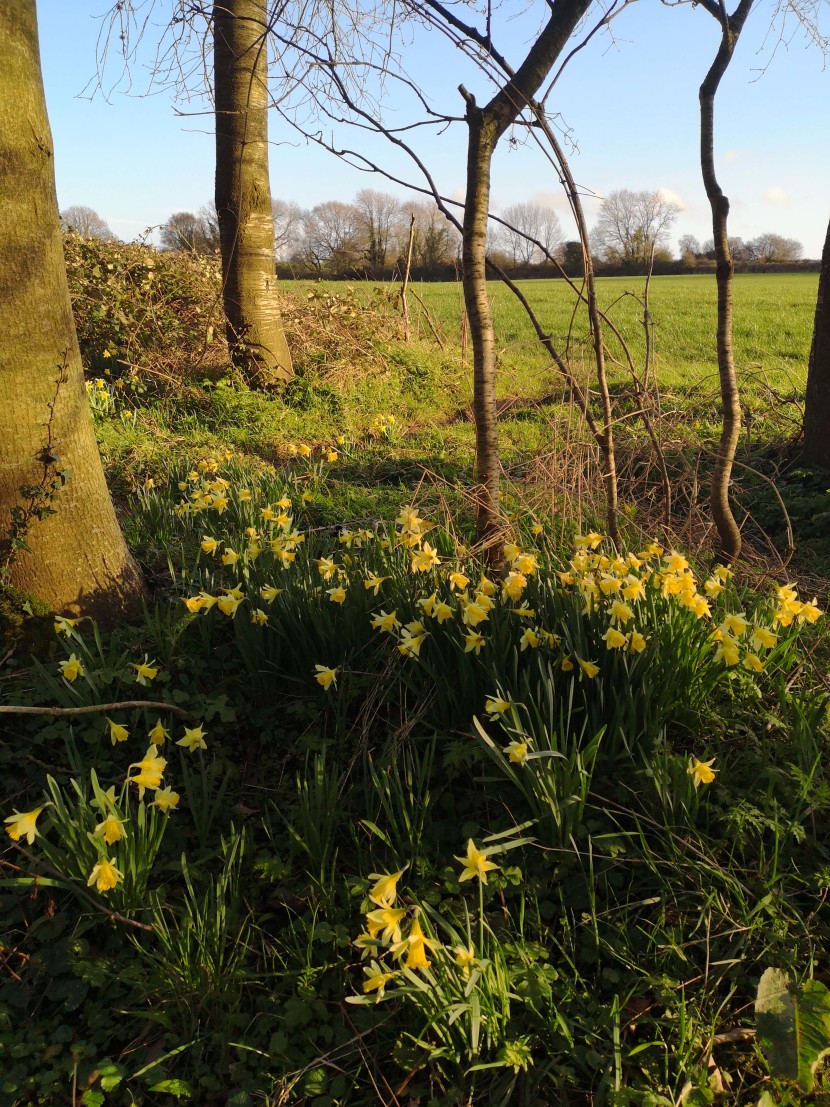 On Bideford Brook
On Bideford Brook However, we had reached the moment where everything changed, in many aspects of British life. I hardly need mention that the Coronavirus epidemic intensified quite rapidly during March, a period during which we were all getting used to the elbow bump handshake and the social isolation concept. These were gloomy times indeed and even the sight of a line of men in a washroom scrubbing their hands while muttering the words of “happy birthday” under their breath failed to raise a smile. Nevertheless, a government pandemic policy based on medical advice and with an assumption of responsible citizenship inspired confidence and was certainly in contrast to draconian lock-down measures applied early on the continent. Angling, we assumed initially, as a famously solitary activity would hardly be considered a threat to ourselves or others. Walton described fishing as the contemplative man’s recreation. Our pleasant and harmless pursuit would be some kind of solace during worrying times. I remembered the foot and mouth outbreak of 20 years ago, while I was home on leave from Afghanistan and we were confined to town. At least this time we would have the countryside to console us if we could be sensible and while free movement was permitted. Just book on-line, jump into the car with your fishing tackle and go and fish a river quietly on your own. There would be no need for contact with anybody and this might just take your mind away from all troubles for a few hours.
Unfortunately Sunday 22nd March, a beautiful and sunny spring day, proved to be a tipping point. Forgetting or ignoring government advice, many flocked to beaches or queued in lines to climb the Brecon Beacons or Snowdonia’s peaks and the media were there to film the stupidity. On the evening of the 23rd the Prime Minister announced a package of stringent “lockdown” measures and emergency legislation was rushed through parliament. The British public were now to remain at home, save for essential work, medical treatment etc. No more pubs, restaurants or cafes. A crucial exception was that one might leave home once a day for “exercise, such as (my italics) walking, running or cycling.” Personally, I still believed that a solitary fishing trip would count as restorative exercise and be no threat to anyone. The Wye and Usk Foundation tended to the same view.
However, a period of confusion followed. The Angling Trust surprised us by asking us to stop fishing and simultaneously wrote a letter to the Minister for Sport assuming that walking, running and cycling were the only approved exercises and asking for permission to fish as well. I’m pretty certain that prior government discussion of the new emergency regulations will not have considered the implications of fishing in any detail, so a decision or clarification on this point may take a while. Government has plenty of other matters to worry about at the moment. Some angling clubs began sending out messages asking their members to stay away from the river. The Cefni reservoir was closed by the local club and Welsh Water closed their reservoirs at Llywn On, Beacons, Usk and Llandegfedd. A rapid round of calls between sports professionals established that most commercial fisheries had closed their doors along with golf clubs and also the local shooting schools and clay pigeon clubs. Obviously any sporting activity which involves people gathering in groups or staying away from home would not be wise and in those cases there could only be one responsible decision. After a good deal of thought, the Foundation which had been hoping to keep fisheries open for solo fishing only and with a number of other precautions against disease transmission, finally decided on 26th March to close down the Passport waters. Obviously this decision is being kept under review.
Of course fishing trips are a relatively trivial affair and no-one wants to take up the time of the police or other government bodies with it at the moment. It’s easy to be accused of being selfish, while so many are deprived of normally harmless pleasures. We started the month worrying about floods, a matter which seems comparatively minor now. Earlier writings about fly boxes or the Lawrence of Arabia movie now look like a rather ineffective form of escapism. I suppose that fishing itself is escapism, but if so, long may it preserve our sanity! Looking ahead, it seems that much that is familiar will be threatened for a while, from our family’s health and safety to the economy. Can we sell our house this year and what about that Mediterranean holiday? We can forget all that for a while. “Life,” as John Lennon famously said, “is what happens while you are making other plans.”
Personally I have confidence in the approach being taken by our government and public health officials, although you can just bet that the media will be working hard to make the situation seem as dramatic as possible and jump on any perceived mistakes. Even the post-Brexit whining has stopped for a while, eclipsed by the new obsession. What is rather annoying is the constant implication from parts of the media or on social networks that our country has failed to train for or consider the implications of epidemics such as this. This, as always, is called “holding government to account.” It would be nice if occasionally journalists could bring themselves to concede that our authorities are really doing quite well in the circumstances. In fact the evidence is this country is one of the best prepared in Europe and the world for such events. Of course we plan for epidemics and this includes our military as well as the civilian health services. In staff college days I never attended a military exercise or war game which did not include epidemic scenarios, usually involving respiratory or dysenteric diseases and a variety of responses available to the players. Looking at the situation globally, apart from the WHO many other international humanitarian organisations gained experience from dealing with ebola. I myself once experienced a limited but frightening outbreak of cholera among programme beneficiaries in Afghanistan. I am confident that the UK will weather this problem, although it may take some time.
I will wish you good health and tight lines as soon as possible.
Oliver Burch
